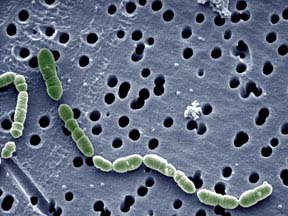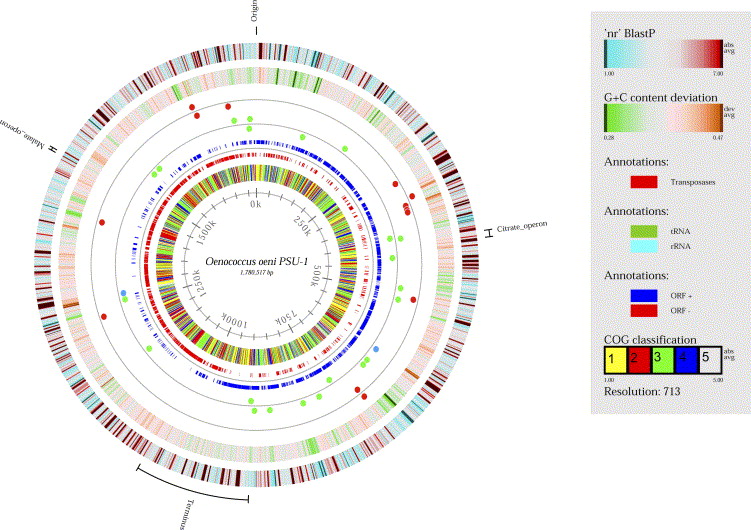Oenococcus oeni
Classification
Domain: Bacteria Phylum: Firmicutes Class: Bacilli Order: Lactobacillales Family: Leuconostocaceae Genus: Oenococcus Species: oeni (1)
NCBI link to find]
Species
|
NCBI: Taxonomy |
Oenococcus oeni
Description and Significance
Oenococcus oeni (previously classified as Leuconostoc oenos) is a gram-positive, nonmotile, chemoorganotrophic lactic acid bacterium that grows in chains of circular to ellipsoidal cells (2). Unlike many bacteria, it thrives in the harsh environment of wine and is considered a beneficial to wine quality and character, rather an agent of damaging value (3). O. oeni is beneficial to wine and the entire field of oenology because of its primary ability to perform malolactic fermentation, the crucial secondary fermentation in the production of wine of converting malic acid to lactic acid. It occurs naturally in musts, wines, and fruit mashes (4).
Genome Structure
In 1995, Dicks et al. sought to reclassify Leuconostoc oenos as Oenococcus oeni because there is little DNA homology between the two genera (2). Oenococcus differs further from Leuconostoc from its abilities to use saccharose, lactose, and maltose as a substrate (5). In 2006, a second Oenococcus species was identified (6). Any strain of O. oeni has a circular genome of 1780517 basepair nucleotides, 1691 protein-coding genes, and 51 RNA genes (7).
Describe the size and content of the genome. Other interesting features? What is known about its sequence?
Cell Structure, Metabolism and Life Cycle
Oenococcus oeni is heterofermentative and can grow in acidic conditions below pH 3.0 (2). It is ethanol tolerant at 10%. The cocci are ellipsoidal to spherical in shape and usually grow in chains or pairs. Optimal growth occurs on sugar and protein rich media, like grape or tomato juice. Lactic acid bacteria, like O. oeni, are typically non-sporulating and
Ecology and Pathogenesis
Habitat; symbiosis; biogeochemical significance; contributions to environment.
Oenococcus oeni stabilizes wine communities by consuming available nutrients and lowering potential growth of other microbes, but its malolactic fermentation can be beneficial or detrimental to the production of wine depending on grapes, climate, and style of wine. Industrial winemakers use a standardized strain of O. oeni, but the many external and environmental variables can dictate the success of the wine.
References
(4) Oenococcus oeni PSU-1. The Regents of the University of California
(9) phys.org “Raise your glass to Oenococcus oeni, a real wine bug”. “Science X Network”. 2014.
Author
Page authored by Drew Wehrle student of Prof. Jay Lennon at Indiana University. .



